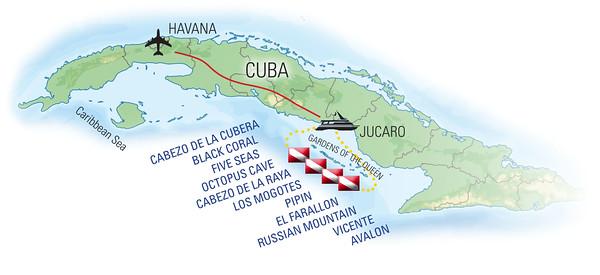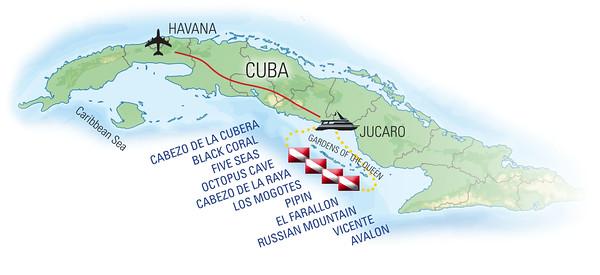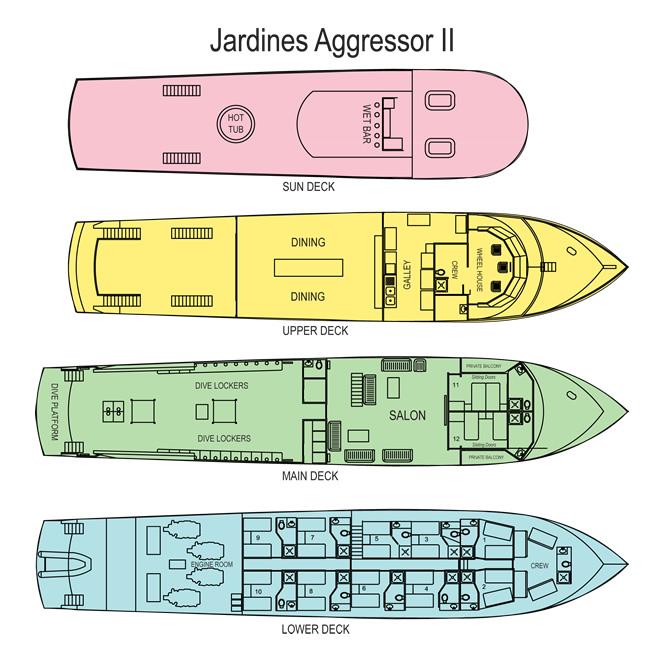Sea Hunter
The Jardines Aggressor II operates 2 programs in Cuba, the first being the Gardens of the Queen and the second being Havana and the Gardens of the Queen.
Cuba's Jardines de la Reina or 'Gardens of the Queen' was named by Christopher Columbus to honor Queen Isabella of Spain. It is located 60 miles off the southeastern coast of Cuba and is the largest marine reserve in the Caribbean. In 1996, the area was declared a National Park and has been protected and managed for conservation ever since. The Gardens of the Queen National Park encompases a chain of 250 pristine coral and mangrove islands extending along 75 miles of clear, turquoise water. It is also widely recognized to represent one of the healthiest marine ecosystems in the Caribbean.
Divers will see pristine coral reefs, steep walls dropping from the reef crest into the deep, large populations of fish including Goliath grouper weighing up to 400 lbs, large schools of multiple snapper species, large rainbow and midnight parrotfishes, eagle rays, sea turtles and much more. Additionally, several species of sharks are commonly seen including silky, caribbean reef, blacktip, lemon, hammerhead, and nurse sharks, plus the occasional whale shark.
For travelers to the Gardens of the Queen, you will spend 7 nights onboard the Jardines Aggressor II liveaboard yacht exploring the spectacular Gardens of the Queen (Jardines de la Reina) National Park. During the week, Cuban specialists will host nightly discussions and presentations on the marine environment, conservation, and the importance of this magnificient ecosystem. Interactive exchanges will discuss how Cuba has maintained one of the healthiest marine ecosystems in the Caribbean.
For travelers on the Havana/Jardines Aggressor II Cuba Group Travel Program, you will spend 2 hotel nights at the Iberostar Parque Central Hotel in Havana, and will attend presentations with Cuban scientists and marine experts and visit the Fortress of El Morro and Habana Vieja before spending a week on the Jardines Aggressor II liveaboard. Seven days of the program will be spent on the Jardines Aggressor II exploring the spectacular Gardens of the Queen (Jardines de la Reina) National Park, located 60 miles off the southern coast. During the week, Cuban specialists will host discussions and presentations on the marine environment, conservation, and the importance of this magnificient ecosystem.

Cabezo de la Cubera
The depth ranges from 18 to 63 ft. “Cabezo” is a Cuban marine term for an isolated coral formation on a sandy bottom. This place has a “cabezo” with a circular shape, around 600 ft in diameter which is extremely impressive with big schools of dog snapper and cuberas in the water column above the coral; mutton, yellowtail snapper schools between the coral patches, Caribbean reef sharks, different species of groupers, sting rays, turtles. After going around the coral formation divers get to a shallow wall with clouds of purple blue tangs and massive schools of tarpon crossing by.
Black Coral I
Depth ranges between 72 and 96 ft. Coral bands that grow higher near the edge of the platform (drop-off) are more than 30 ft high over the sand patches in the bottom between them, abundant colonies of black coral, a resident population of more than 20 Caribbean reef sharks, huge black groupers come close to the divers all the time, schools of jacks rubbing their bodies against the sharks to clean parasites away, parrot fish schools, clouds of school masters and yellowtail snappers, also rainbow runners and oceanic triggerfish.
Black Coral II
Depth ranges between 60 and 90 ft. Impressive coral mountains near the edge of the platform, resident population of more than 25 reef sharks (Carcharinus Perezi) patrolling the coral mountains. Big colonies of black corals, large sponges, depth gorgonians, midnight parrotfish schools, king mackerel, black groupers, moray eels, hawksbill, and a friendly nurse shark comes very close to the divers. In the blue passing schools of oceanic triggerfish and lonely eagle rays.
Five Seas
Depth ranges between 21 and 66 ft. Under the wall there are overhangs with impressive resident schools of tarpon, black corals, and colorful sponges, divers go under and tarpons get as close as two inches from the mask to turn away with a shining silver flash. Resident population of more than 15 Caribbean reef sharks, snappers, black groupers, Goliath grouper (Epinephelus Itajara) comes very close. There is a wreck 15 meters long, it was a boat of Júcaro harbor that was used as a pilot boat and its name was Five Seas, was sunk intentionally, the remaining parts of the boat are full of corals, sponges, schools of jacks and black corals, also green moray eels.
Octopus Cave
Depth ranges between 15 and 54 ft. There is a wall full of sponges and gorgonians, tarpon schools, Caribbean reef sharks and Goliath groupers over 200 pounds, impressive schools of grunts, porgies and mullet around big pillar corals in the edge of the wall, also big clouds of school masters.
Pillar corals are over 6 feet high and are cleaning stations for large and small reef fish. There is a cave at 18 feet with a horizontal development of its gallery of over 230 ft., but it is restricted and you can only explore the entrance, the cave is inhabited by “brotulas”, a blind fish, they can only be seen at night. There are also iridescent sponges with decorated crabs.
Cabezo de la Raya
Depth between 15 and 63 ft. Circular coral formation more than 900 ft. in diameter, forming bands of coral in the sand, many sting rays in the sandy areas, nurse sharks, Caribbean reef sharks, Goliath grouper, black and Nassau groupers, hawksbills, king mackerel. At the end the dive finishes at 15 ft. in a shallow wall full of reef fish, grunts, schoolmasters, parrots, barracudas, angelfish, blue tangs, mullet, nudibranchs, etc.
Los Mogotes
Amazing visibility, “Mogotes” is the name Cuban fishermen give to coral formations in a white sandy bottom, as they see these from the boat as darker areas in the sand.
Depth ranges between 21 and 63 ft. There is a wall with some overhangs full of black coral, small caves with tarpon schools especially in May, June, July, constantly patrolled by Caribbean reef sharks, big black groupers, jacks, crabs, and many reef fish in the shallow zone.
Pipin
Drop-off wall dive, between 45 and 105 ft. deep, with many coral canyons, resident school of Silky sharks (Carcharhinus falciformis) swimming near the boat all the time and Caribbean reef sharks in the deep. Black corals, huge spotted eagle rays, tarpon, jacks, snappers, turtles. Big colonies of black corals.
El Farallon
Coral formation between 45 and 160 ft. crossed by some ruptures where the corals are 30ft. high over the sand and 6 ft. wide, some of this impressive tunnels barely open in the top allowing the rays of light to enter forming an spectacular view, divers go across two tunnels and then go to the drop-off full of black corals and hanging sponges, black groupers, goliath grouper, snapper, caribbean reef sharks and silky sharks.
Russian Mountain
Drop-off, perpendicular wall, the dive goes between 66 and 105 ft. with large coral canyons, big schools of jacks, black corals, huge sponges, Silky and Caribbean reef sharks, occasionally a giant lonely great hammerhead (Sphirna mokarran) emerges from the depth to take a quick view of the divers. Turtles, snappers, and groupers.
Vicente
Large cylindrical coral formations at the edge of the wall as pinnacles that rise 72 ft. from a deep sandy bottom, the dive goes between 114 and 60 ft. from top to top of these intricately decorated coral mountains, with all species of sponges, corals, gorgonians, very colorful drop-off, also large groupers, Caribbean and Silky sharks, and occasionally a huge great hammerhead comes up curious. Spotted eagle rays flying parallel to the wall.
Avalon
Frontal edge of the reef wall, between 72 and 110 ft. full of big black coral colonies, and depth gorgonians, groupers, silky and Caribbean reef sharks, massive iridescent sponges, is a very colorful wall, eagle rays are seen here very often, also goliath groupers, hammerheads occasionally. Some impressive canyons in the deeper areas of the wall.

Thursday Day 1
Welcome and pick-up at Havana International Airport is between 10:45am – 3:30 pm, transfer to hotel, check in 4 pm and dinner at 7 pm with Cuban hosts to learn about Cuba’s marine conservation programs.
Friday Day 2
Breakfast then marine conservation program in conference room at hotel. Visit to Fortress of El Morro, lunch and afternoon cultural tour of Old Havana. Dinner at 7 pm with Cuban hosts and to learn about Cuba’s marine conservation programs then a visit to a Cuban neighborhood.
Saturday Day 3
7 – 7:30 am Breakfast then an 8 am bus transfer to Jucaro to board the Jardines Aggressor II. Lunch will be served on the yacht after arrival at approximate 3 pm boarding.
Sunday – Friday Day 4 – 9
Diving in the Gardens of the Queen and marine programs with Cuban biologists and experts.
Saturday Departure Day 10
4 – 5 am Transfer to Havana International Airport for arrival at approximately 12 noon. Most airlines require a 2 hour check-in prior to flight. Travelers will stop for lunch on the way to the airport.
Gardens of the Queen Dive Sites
Cabezo de la Cubera
The depth ranges from 18 to 63 ft. “Cabezo” is a Cuban marine term for an isolated coral formation on a sandy bottom. This place has a “cabezo” with a circular shape, around 600 ft in diameter which is extremely impressive with big schools of dog snapper and cuberas in the water column above the coral; mutton, yellowtail snapper schools between the coral patches, Caribbean reef sharks, different species of groupers, sting rays, turtles. After going around the coral formation divers get to a shallow wall with clouds of purple blue tangs and massive schools of tarpon crossing by.
Black Coral I
Depth ranges between 72 and 96 ft. Coral bands that grow higher near the edge of the platform (drop-off) are more than 30 ft high over the sand patches in the bottom between them, abundant colonies of black coral, a resident population of more than 20 Caribbean reef sharks, huge black groupers come close to the divers all the time, schools of jacks rubbing their bodies against the sharks to clean parasites away, parrot fish schools, clouds of school masters and yellowtail snappers, also rainbow runners and oceanic triggerfish.
Black Coral II
Depth ranges between 60 and 90 ft., impressive coral mountains near the edge of the platform, resident population of more than 25 reef sharks (Carcharinus Perezi) patrolling the coral mountains. Big colonies of black corals, large sponges, depth gorgonians, midnight parrotfish schools, king mackerel, black groupers, moray eels, hawksbill, and a friendly nurse shark comes very close to the divers. In the blue passing schools of oceanic triggerfish and lonely eagle rays.
Five Seas
Depth ranges between 21 and 66 ft. under the wall there are overhangs with impressive resident schools of tarpon, black corals, and colorful sponges, divers go under and tarpons get as close as two inches from the mask to turn away with a shining silver flash. Resident population of more than 15 Caribbean reef sharks, snappers, black groupers, Goliath grouper(Epinephelus Itajara) comes very close. There is a wreck 15 meters long, it was a boat of Júcaro harbor that was used as a pilot boat and its name was Five Seas, was sunk intentionally, the remaining parts of the boat are full of corals, sponges, schools of jacks and black corals, also green moray eels.
Octopus Cave
Depth ranges between 15 and 54 ft. there is a wall full of sponges and gorgonians, tarpon schools, Caribbean reef sharks and Goliath grouper over 200 pounds, impressive schools of grunts, porgies and mullet around big pillar corals in the edge of the wall, also big clouds of school masters.
Pillar corals are over 6 feet high and are cleaning stations for large and small reef fish There is a cave at 18 feet with a horizontal development of its gallery of over 230 ft., but it is restricted and you can only explore the entrance, the cave is inhabited by “brotulas”, a blind fish, they can only be seen at night. There are also iridescent sponges with decorated crabs.
Cabezo de la Raya
Depth between 15 and 63 ft. Circular coral formation more than 900 ft. in diameter, forming bands of coral in the sand, many sting rays in the sandy areas, nurse sharks, Caribbean reef sharks, goliath grouper, black and Nassau groupers, hawksbills, king mackerel, at the end the dive finishes at 15 ft. in a shallow wall full of reef fish, grunts, schoolmasters, parrots, barracudas, angelfish, blue tangs, mullet, nudibranchs etc.
Los Mogotes
Amazing visibility, “Mogotes” is the name Cuban fishermen give to coral formations in a white sandy bottom, as they see these from the boat as darker areas in the sand.
Depth ranges between 21 and 63 ft. there is a wall, with some overhangs full of black coral, small caves with tarpon schools especially in May, June, July, constantly patrolled by Caribbean reef sharks, big black groupers, jacks, crabs, and many reef fish in the shallow zone.
Pipin
Drop-off wall dive, between 45 and 105 ft. deep, with many coral canyons, resident school of Silky sharks (Carcharhinus falciformis) swimming near the boat all the time and Caribbean reef sharks in the deep. Black corals, huge spotted eagle rays, tarpon, jacks, snappers, turtles. Big colonies of black corals.
El Farallon
Coral formation between 45 and 160 ft. crossed by some ruptures where the corals are 30ft. high over the sand and 6 ft. wide, some of this impressive tunnels barely open in the top allowing the rays of light to enter forming an spectacular view, divers go across two tunnels and then go to the drop-off full of black corals and hanging sponges, black groupers, goliath grouper, snapper, Caribbean reef sharks and silky sharks.
Russian Mountain
Drop-off, perpendicular wall, the dive goes between 66 and 105 ft. With large coral canyons, big schools of jacks, Black corals, huge sponges, Silky and Caribbean reef sharks, occasionally a giant lonely great hammerhead (Sphirna mokarran) emerges from the depth to take a quick view of the divers. Turtles, snappers, and groupers.
Vicente
Large cylindrical coral formations at the edge of the wall as pinnacles that rise 72 ft. from a deep sandy bottom, the dive goes between 114 and 60 ft. from top to top of these intricately decorated coral mountains, with all species of sponges, corals, gorgonians, very colorful drop-off, also large groupers, Caribbean and Silky sharks, and occasionally a huge great hammerhead comes up curious. Spotted eagle rays flying parallel to the wall.
Avalon
Frontal edge of the reef wall, between 72 and 110 ft. full of big black coral colonies, and depth gorgonians, groupers, silky and Caribbean reef sharks, massive iridescent sponges, is a very colorful wall, eagle rays are seen here very often, also goliath groupers, hammerhead occasionally. Some impressive canyons in the deeper areas of the wall.
The Yacht - Jardines Aggressor II
Port: Jucaro, Cuba
Located south of Ciego de Avila and 60 miles north of Gardens of the Queen.
Built and maintained to SOLAS shipping standards.
- Length: 135 ft.
- Beam: 25
- Passengers: 24
- Crew: 12
- Boarding: Saturday afternoon
- Disembark: Saturday 4 a.m.
Stateroom Details:Room #1 Deluxe Stateroom
Rm Size: 9ft x 9ft (no porthole/window)
Side by Side twins
38 x 75 inches
38 x 75 inchesRoom #2 Deluxe Stateroom
Rm Size: 9ft x 9ft feet (no porthole/window)
Side by Side twins
38 x 75 inches
38 x 75 inchesRoom #3 Deluxe Stateroom
Rm Size: 8ft x 8ft 6in with porthole
Side by Side twins
38 x 75 inches
38 x 75 inchesRoom #4 Deluxe Stateroom
Rm Size: 8ft x 8ft 6in with porthole
Side by Side twins
38 x 75 inches
38 x 75 inchesRoom #5 Deluxe Stateroom
Rm Size: 8ft x 8ft with porthole
Side by Side twins or king
38 x 75 inches
38 x 75 inchesRoom #6 Deluxe Stateroom
Rm Size: 8ft x 7ft feet with porthole
Side by Side twins or king
38 x 75 inches
38 x 75 inchesRoom #7 Deluxe Stateroom
Rm Size: 8ft x 7ft 6in with porthole
Side by Side twins or king
38 x 75 inches
38 x 75 inchesRoom #8 Deluxe Stateroom
Rm Size: 8ft x 8ft feet with porthole
Side by Side
twins or king
38 x 75 inches
38 x 75 inchesRoom #9 Deluxe Stateroom
Rm Size: 10ft x 8ft feet with porthole
Side by Side twins or king
38 x 75 inches
38 x 75 inches
Room #10 Deluxe Stateroom
Rm Size: 10ft x 8ft feet with porthole
Side by Side twins
or king
38 x 75 inches
38 x 75 inches
Room #11 Balcony Suite
Rm Size: 10ft x 8ft feet with sliding glass doors
Side by Side twins or king
38 x 75 inches
38 x 75 inches
Room #12 Balcony Suite
Rm Size: 10ft x 8ft feet with sliding glass doors
Side by Side twins or king
38 x 75 inches
38 x 75 inches

